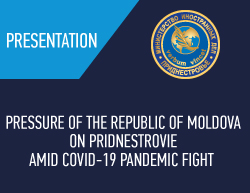Country Overview
The Pridnestrovien Moldavian Republic (Pridnestrovie) is a state located in the south-eastern part of Europe which occupies the left bank of the Dniester River within the borders of the former Moldavian SSR, and a number of settlements on the right bank, i.e. the city of Bendery with adjacent villages and villages of the Slobodzeya raion such as Copanca, Kitskany, Mereneshty, and Cremenciug.
Pridnestrovie is landlocked and borders the Republic of Moldova along the Dniester River to the west (for 411 km) and Ukraine to the south-east (for 405 km).
The total area of Pridnestrovie is 4163 km² which makes up 10% of the territory of the former MSSR.
The border's total length is 816 km.
The total population of the PMR equals 555 thousand, with three major ethnic groups being Moldovans (31.9%), Russians (30.4%), and Ukrainians (28.8%).
The capital of the Republic is the city of Tiraspol with the population of 144 thousand.
Official languages of the Pridnestrovien Moldavian Republic are Moldavian, Russian and Ukrainian.
The majority of the population professes Christianity (Russian Orthodox Church).
The monetary unit of the Republic is the Pridnestrovien ruble.
Government and Administrative-Territorial System of the PMR
The Pridnestrovien Moldavian Republic (Pridnestrovie) is a sovereign, independent, democratic, legal and secular state.
The Pridnestrovien state has its own Constitution, controlled territory, legislation, market economy, developed financial and tax systems, modern communications infrastructure, army, militia, security service, national flag, coat-of-arms, and anthem.
The nation-wide referenda carried out on the whole territory of Pridnestrovie, as well as Congresses of People's Deputies of all levels brought about the inception of the Pridnestrovien statehood.
The Pridnestrovien Moldavian Republic was proclaimed on September 2, 1990, at the Second Congress of People's Deputies of all levels. It is as an official date of the Pridnestrovien statehood restoration, and the Second of September is a state holiday of the PMR called the Day of the Republic.
The First Constitution of independent Pridnestrovie was adopted on September 1, 1990. Based on it, the Supreme Council was created, first nation-wide Presidential elections were carried out on alternative base in 1991, and supreme bodies of judicial power and law-enforcement system were formed.
On December 24, 1995, during the national referendum, a new Constitution of Pridnestrovie was adopted which established the PMR as a democratic, legal, and sovereign state with parliamentary-presidential form of government. Human rights were declared to be priority for the state.
The head of the state is the President. The PMR's current President is Yevgeny Shevchuk.
The President is elected for a term of five years. He is the head of the state and chief executive, appoints the Cabinet of Ministers, carries out general direction over all government structures and coordinates their work. He represents the Republic in its international relations and is the Commander in Chief of the Republican Armed Forces.
The supreme legislative and representative body of the PMR is Supreme Soviet (Supreme Council) elected to a five year term with a majority voting. The Supreme Soviet is headed by the Chairman of the Supreme Soviet who is elected from among its members (the Supreme Soviet consists of 43 members).
All state bodies have been established and are properly functioning in Pridnestrovie, including legislative (the Supreme Soviet and local councils), executive (the Cabinet of Ministers which consists of ministers and heads of departments constituting part of the single system of executive organs of state power, and also of the heads of State Administrations of towns and districts); judicial (the Constitutional Court, the Supreme Court, the Court of Arbitration (economic court), town and district courts), as well as the Prosecutor's Office as independent supervising body and Audit Chamber.
Administratively, Pridnestrovie is subdivided into administrative-territorial units of two levels, with the highest level being represented by 5 raions(districts) which are Grigoriopol, Dubossary, Kamenka, Rybnitsa, and Slobodzeya raions, and also by the cities of Tiraspol (together with Dnestrovsk), Bendery, Rybnitsa, and Dubossary which stay as independent administrative- territorial units. The first-level territorial units of the PMR are cities of local significance, i.e. Slobodzeya, Grigoriopol, and Kamenka, as well as village Soviets (local councils) and rural communities. Pridnestrovie has a total of 147 villages.
Production and Industrial Capacity of the PMR
Pridnestrovie is an agro-industrial state.
Industrial production plays the leading role in the Pridnestrovien economy. More than 37 thousand of people work in the sphere of industry. The share of industry in the GDP is more than 30%. Payments of industrial enterprises make up more than 60% of the total amount of the budget payments and extra-budgetary funds.
More than 110 enterprises form the basis of the Pridnestrovien industry.
The leading branches of economy of the PMR are electric-power industry, iron and steel industry, food-processing and light industries, engineering, metalworking, and production of building materials. Enterprises of chemical industry, woodworking and furniture trade, printing, glass, flour-and-cereals industries contribute significantly to Republic's economy.
More than 500 producing enterprises are operating in the sphere of small business.
The core types of industrial enterprises production are energy, rolling of ferrous metals, casting machines, electric machines and pumps, low-voltage facilities, cable goods, electrically insulating materials, cement, fiberglass, furniture, cotton fabric, shoes, garment, wine-cognac and liquor-vodka products.
Activity of the Pridnestrovien enterprises targets to external markets – about 90% of the total output is shipped to the CIS and Far Abroad countries. Thereby, the annual volume of export deliveries goes beyond $ 800 million US dollars.
Industrial enterprises of Pridnestrovie maintain trade and economic relations with almost 90 countries of the world, constantly improving and enhancing commodity turnover mechanism.
Relatively advantageous economic-geographical position and infrastructure availability stand as factors fostering the development of industry and agriculture. Pridnestrovie is a country with high agro-climatic and biological soil capacity. The Republic enjoys the developed transport infrastructure with two railways and two trunk routs of international significance running through its territory, as well as the three main gas pipelines linking Russia with the countries of Eastern and South-Eastern Europe. Energy generating enterprises fully cover the requirements of the industrial production, social sphere and population.
InternationalandPoliticalSituation
The creation of the Pridnestrovien Moldavian Republic was a natural logical result of the processes which began to develop after the dissolution of the Soviet Union.
This was an important decision that embodied the will of the Pridnestrovien people expressed at the nation-wide referenda and that made it possible to protect lawful interests of the Pridnestroviens, preserve centuries-long historic and cultural traditions, ensure for the people the right to live on the land of their forefathers affording an opportunity for equal development of all the nations residing in the Republic.
The genocide policy implemented by the Republic of Moldova resulted in the full-scale aggression of Moldova against Pridnestrovie. In 1992, during the period of the armed conflict, hundreds of citizens of Pridnestrovie were killed, tens of thousands lost their homes having been made refugees.
The necessity to settle relations based on the aspiration to eliminate the possibility of a repeated armed conflict predetermined – two years after the armed aggression of Moldova – the start of negotiations of the Pridnestrovien Moldavian Republic with the Republic of Moldova.
One of the major foreign policy goals of Pridnestrovie is to entrench stability and security in the region. To meet this goal, the mechanism of the peacekeeping operation, which includes the Joint Peacekeeping Forces and the Joint Control Commission, as well as mediation of authoritative countries and international organisations, is actively used nowadays.
During a long-term period of the Moldova-Pridnestrovie settlement, more than 80 documents and agreements have been signed and participation of mediators and guarantors of the fulfilment of the reached documents has been provided. Presently, in the framework of the Moldova-Pridnestrovie settlement besides the parties to the conflict, i.e. Moldova and Pridnestrovie, five more subjects are involved as well – the Russian Federation and Ukraine as guarantor countries of the earlier reached agreements and mediators; the OSCE as a mediator, and also the European Union and the USA in a status of observers within the Permanent Consultations on Political Issues in the Framework of the Pridnestrovien Settlement Negotiation Process, which is of consultative character (the five plus two format).
In compliance with the Foreign Policy Concept of the PMR, the fundamental priorities of the foreign policy of the Pridnestrovien Moldavian Republic are as follows:
a) strengthening and defending its independence and sovereignty;
b) protection of human rights, freedoms, and dignity regardless of ethnicity;
c) openness in developing equitable and mutually advantageous relations with the states of the Near and Far Abroad countries;
d) commitment to only peaceful, politico-democratic, negotiating methods in the settlement of relations with the Republic of Moldova;
e) ensuring favourable external conditions for promoting socio-economic reforms in order to improve well-being of the population.
Realization of national interests of the Pridnestrovien Moldavian Republic is mainly ensured through the development of friendly, mutually beneficial relations with adjoining states, leading world powers and integration associations of the international community.
Since the first days of its independent development, the Pridnestrovien Moldavian Republic has established, maintained and has been actively extending friendly interstate relations with the Republic of Abkhazia, the Republic of South Ossetia and the Republic of Nagorno-Karabakh.
The pivotal vector of the foreign policy of the Pridnestrovien Moldavian Republic was once again confirmed during the nation-wide 17 September 2006 Referendum, at which 97,2% of the citizens of Pridnestrovie spoke in favour of “the course towards the independence of the Pridnestrovien Moldavian Republic and the subsequent free association of Pridnestrovie with the Russian Federation”
The modern Pridnestrovie aims at developing multilevel bi- and multilateral relations, primarily with Russia and Ukraine, as well as with near- and far-abroad countries which are based on the objective account for mutual interests, balanced and pragmatic approach, understanding of the present-day realities and latest tendencies in the sphere of international relations.







